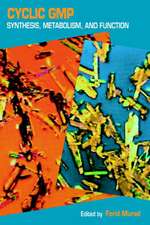Advances in Antiviral Drug Design: Advances in Antiviral Drug Design, cartea 4
Editat de E. De Clercqen Limba Engleză Hardback – 16 dec 2003
First, as the introductory chapter, the different new anti-HIV agents that are now in preclinical or clinical development are reviewed by E. De Clercq. This includes new NRTIs, NNRTIs and PIs, but also HIV entry/fusion inhibitors as well as integrase inhibitors, and some of these agents, such as the NRTI emtricitabine [(-)FTC] and the PI atazanavir, may soon be licensed for clinical use.
Second, high expectations are vested in the potential therapeutic usefulness of inhibitors of HIV integration, a point of no return in the life cycle of HIV, and this approach is highlighted by D.J. Hazuda and S.D. Young.
Third, as all currently available PIs can be described as "peptidomimetic", and, therefore, expected to demonstrate overlapping virus-drug resistance and side effect profiles, it would be interesting to see how a non-peptidic protease inhibitor such as tipranavir behaves, and this is covered by D. Mayers, K. Curry, V. Kohlbrenner and S. McCallister.
Fourth, neuraminidase inhibitors such as zanamivir (that has to be inhaled) and oseltamivir (that can be administered via the oral route) have gained a definitive status as antiviral drugs useful for both therapy and prophylaxis of influenza A and B virus infections; as they target a specific influenza viral enzyme, neuraminidase (or sialidase), they may be expected to block newly emerging influenza viruses as well, and the design of neuraminidase inhibitors has received due attention of H. Jin and C.U. Kim.
Fifth, while the major current efforts in antiviral drug development have shifted from herpesviruses towards HIV and hepatitis viruses [hepatitis B virus (HBV), hepatitis C virus (HCV)], it is interesting to note that by switching from the classical five-membered sugar or acyclic nucleoside strategy, J. Wang, M. Froeyen and P. Herdewijn have gone "upstream" in designing six-membered carbocyclic nucleosides as potential anti-herpesvirus agents.
Sixth, following up on the nucleotide prodrug strategy introduced above under ix, to deliver the biologically active nucleotides inside the cells, C. Meier has elaborated on a particular class of such pronucleotides, namely that of the cyclosaligenyl pronucleotides, an approach that should have far reaching implications for compounds effective against HIV, HBV and other viruses.
The six topics covered in this fourth volume of Advances in Antiviral Drug Design are in the front line of the present endeavors towards the design and development of new therapeutic agents for virus infections. They pertain to the combat against three of the most important viral pathogens of current times: HIV, HBV, influenza virus and herpesviruses.
| Toate formatele și edițiile | Preț | Express |
|---|---|---|
| Hardback (2) | 615.32 lei 36-50 zile | |
| ELSEVIER SCIENCE – 29 iul 2007 | 615.32 lei 36-50 zile | |
| ELSEVIER SCIENCE – 16 dec 2003 | 708.76 lei 43-57 zile |
Preț: 708.76 lei
Preț vechi: 970.90 lei
-27% Nou
Puncte Express: 1063
Preț estimativ în valută:
135.64€ • 141.09$ • 111.98£
135.64€ • 141.09$ • 111.98£
Carte tipărită la comandă
Livrare economică 14-28 aprilie
Preluare comenzi: 021 569.72.76
Specificații
ISBN-13: 9780444506023
ISBN-10: 0444506020
Pagini: 230
Dimensiuni: 152 x 229 x 15 mm
Greutate: 0.5 kg
Editura: ELSEVIER SCIENCE
Seria Advances in Antiviral Drug Design
ISBN-10: 0444506020
Pagini: 230
Dimensiuni: 152 x 229 x 15 mm
Greutate: 0.5 kg
Editura: ELSEVIER SCIENCE
Seria Advances in Antiviral Drug Design
Cuprins
List of contributors. Preface. New anti-HIV agents in preclinical or clinical development (E. De Clercq). Inhibitors of human immunodeficiency virus integration (D.J. Hazuda, S.D. Young). Non-peptidic protease inhibitors (NPPIs): Tipranavir (D. Mayers et al.). Design of neuraminidase inhibitors as anti-influenza virus agents (H. Jin, C.U. Kim). Six-membered carbocyclic nucleosides (J. Wang, M. Froeyen, P. Herdewijn). cycloSal-pronucleotides - Design of the concept, chemistry and antiviral activity (C. Meier). Index.
Recenzii
"All six chapters in the current volume are up-to-date, interesting reading, and written by experts on each subject...The first chapter on "New Anti-HIV Agents in Preclinical or Clinical Development" is written by the editor, who is a recognized authority in this area. It is an excellent overview of current advances in the clinic and laboratory. Not only does this review thoroughly cover drugs acting by conventional mechamisms, such as reverse transcriptase and protease inhibition, it also details agents operating by novel mechanisms...A highlight of the volume is the chapter by Gilead co-workes Jin and Kim entitled "Design of Neuraminidase Inhibitors as Anti-Influenza Virus Agents". This is an excellent description of the medical chemistry of an important new class of antiviral drugs based on enzyme X-ray structures and structure-activity relationships...it provides very useful information and it is thorough in some areas...it should be an essential acquisition for complete libraries in academic institutions and pharmaceutical companies." --Thomas W. Bell, University of Nevada, Reno for JOURNAL OF THE AMERICAN CHEMICAL SOCIETY, Vol. 126, 2004















